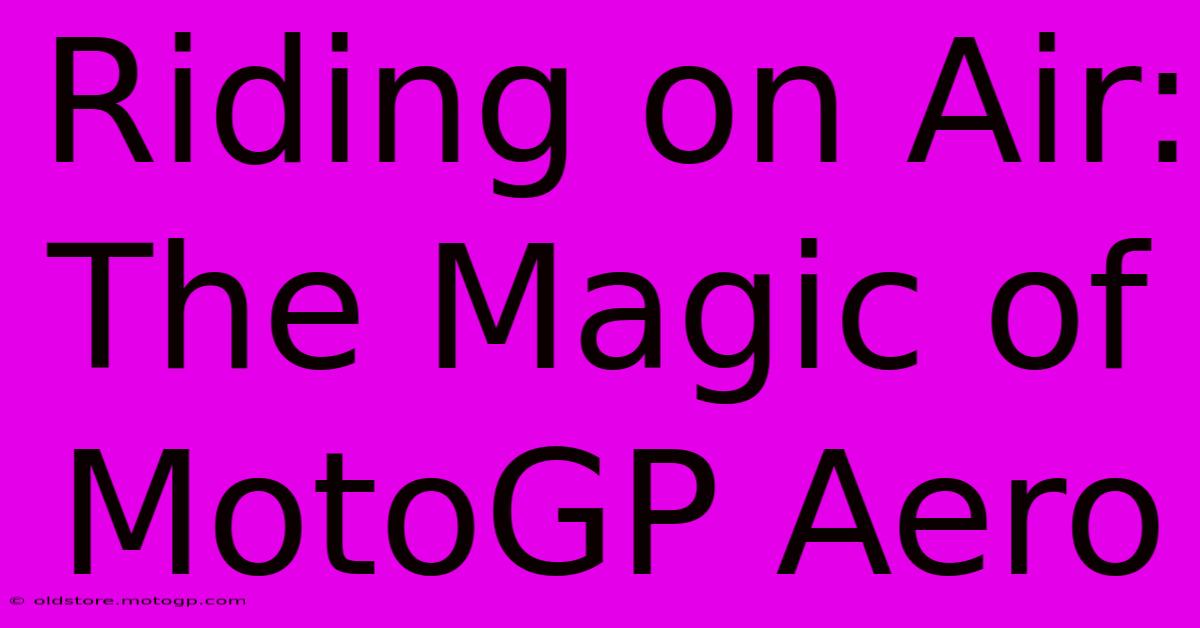Riding On Air: The Magic Of MotoGP Aero

Table of Contents
Riding on Air: The Magic of MotoGP Aero
MotoGP. The pinnacle of motorcycle road racing. The roar of the engines, the breathtaking speeds, the hair-raising overtakes… it's a spectacle of skill and technology. But beneath the surface of the thrilling races lies a crucial, often-overlooked element: aerodynamics. This isn't just about speed; it's about control, stability, and ultimately, winning. Let's delve into the magic of MotoGP aero.
The Science of Speed: Understanding MotoGP Aerodynamics
MotoGP bikes aren't just powerful; they're aerodynamic masterpieces. At speeds exceeding 200 mph (320 km/h), even the smallest aerodynamic advantage can translate into crucial seconds gained or lost over a race. The engineers meticulously design every component, from the fairings and winglets to the rider's position, to minimize drag and maximize downforce.
Drag Reduction: The Quest for Speed
Drag is the resistance a bike encounters as it moves through the air. Reducing drag is paramount for achieving higher top speeds. MotoGP teams use sophisticated Computational Fluid Dynamics (CFD) simulations and wind tunnel testing to refine the shape of the fairings, minimizing turbulence and streamlining airflow. Even small changes to the fairing's curvature can significantly impact drag, impacting acceleration and top speed.
Downforce Generation: Cornering Mastery
While reducing drag is essential for straight-line speed, downforce is crucial for cornering. Downforce is the aerodynamic force pushing the bike down onto the track, improving grip and stability at high speeds. This is where the winglets, those small aerodynamic appendages on the front and sometimes rear of the bikes, play a critical role. These winglets generate downforce, allowing riders to carry more speed through corners, making for breathtaking overtaking maneuvers and faster lap times.
The Rider's Role in Aerodynamics
The rider isn't just a passenger; they're an integral part of the aerodynamic package. Their position on the bike, their body shape, and even their suit design contribute to the overall aerodynamic performance. Riders often adopt tucked positions to minimize drag on the straights, while adjusting their posture in corners to optimize downforce and stability. The rider's suit itself is designed to be aerodynamically efficient, minimizing wind resistance and improving overall performance.
The Evolution of MotoGP Aero: From Simple Fairings to Complex Winglets
MotoGP aerodynamics have evolved dramatically over the years. Early bikes featured relatively simple fairings, primarily focused on rider protection. However, as speeds increased, the importance of aerodynamics became increasingly apparent. The introduction of winglets marked a significant turning point, providing a more direct and effective way to generate downforce.
The evolution continues, with teams constantly experimenting with new designs and materials. The use of advanced materials, such as carbon fiber, allows for lighter and stronger components, further enhancing aerodynamic performance. The designs become increasingly complex, pushing the boundaries of what's aerodynamically possible.
The Future of MotoGP Aero: Pushing the Limits
The future of MotoGP aero is likely to involve even more sophisticated designs and technologies. We can expect to see further refinement of existing components, as well as the introduction of new aerodynamic solutions. The quest for marginal gains will continue, driving innovation and pushing the limits of what's achievable on two wheels. The ongoing developments in materials science and computational fluid dynamics will undoubtedly play a vital role in this ongoing evolution. The fight for milliseconds, driven by ever-improving aerodynamics, will keep MotoGP at the forefront of motorsport innovation for years to come.
Conclusion:
The magic of MotoGP aero isn't just about speed; it's about precision, control, and the constant pursuit of perfection. It's a testament to the ingenuity and dedication of the engineers and riders who push the boundaries of what's possible, delivering the breathtaking spectacle we witness each race weekend. From drag reduction to downforce generation, every aspect is meticulously designed to deliver an edge in the fiercely competitive world of MotoGP. The ongoing evolution of this crucial technology will continue to shape the future of motorcycle racing, promising even more thrilling races in the years to come.

Thank you for visiting our website wich cover about Riding On Air: The Magic Of MotoGP Aero. We hope the information provided has been useful to you. Feel free to contact us if you have any questions or need further assistance. See you next time and dont miss to bookmark.
Featured Posts
-
Bike Racing On Tv More Than Just A Race
Feb 23, 2025
-
The Passion The Drama The Speed Tnt Sports Moto Gp
Feb 23, 2025
-
Moto Gp Top Speed Riding On The Edge
Feb 23, 2025
-
Moto2 Bike Specs A Deep Dive Into The Technology
Feb 23, 2025
-
Moto 2 Bike Specs Beyond The Limits
Feb 23, 2025
